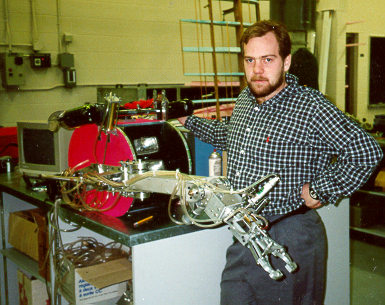I must admit, that I was surprised by the old “vestigial organs” argument. I really shouldn’t have been, but I was. I thought these evolutionists had grown up past these childish things by now, but I forgot – this is a propaganda piece. I am also absolutely blown away by how imagination is portrayed as science in this segment, and just how utterly ludicrous these imaginations are! Hold on to your hats, this is going to get wierd.
Vestigial organs?
(appendix image from Gray’s anatomy, 20th US edition)
According to the theory of evolution, we “evolved” from lower life forms. A simplified rendition would be that a frog turned into a prince, and that prince happened to be your ancient ancestor, so you happen to have had a frog in your distant past. In case you think I’m exagerating, wait for it.
As a result of this step-by-gradual-step process, leftovers from the frog, or fish, or whatever, remain in your body. These are called vestigial organs.
Some evolutionists may claim that we are still evolving, and thus some of your organs are a step in your evolution into…. whatever it is yer evolvin’ into. And these extra / extraneous organs would be called “nascent” organs as they are first appearing.
For the record, I know of no evolutionist who is claiming any organ we have is nascent, but I thought I’d mention it because you will encounter that term when dealing with theoretical evolution in the fossil record.
 There was once a loooong list of supposed supposed recognized “Vestigial organs.” The list was well over 100 quite a few years back, but funny – the list has slooowly dwindled down to a scant ZERO.
There was once a loooong list of supposed supposed recognized “Vestigial organs.” The list was well over 100 quite a few years back, but funny – the list has slooowly dwindled down to a scant ZERO.
Why? Because what was thought to be “vestigial organs” (for no other reason than evolutionary bias and preconceptions I might add!) turned out to be organs that served a purpose! Stay tuned to this concept, as I will revisit this in the “Evolution in the everyday world” segment.
For example, it was not long ago that the appendix was cut out of people regularly (see image right). All too often it was when there was absolutely nothing wrong with the person’s appendix, but the doctors were going in for surgery in that area anyway, and “it serves no purpose – it’s just a leftover from our evolutionary ascent anyway – let’s cut it out and be done with it.”
In fact, Wikipedia still lists the appendix as a vestigial organ: http://en.wikipedia.org/wiki/Vestigial_organ
Turns out the appendix is the “storehouse” for beneficial bacteria. These bacteria normally reside in your intestine and help you digest your food. Sometimes, due to illness, your body gets rid of the bacteria. The culture in your appendix helps repopulate your intestine.
Creationists would claim that we were designed, therefore, every organ and body part has a function and a purpose. So one must first realize that not knowing what a body part does, only speaks of our ignorance, not our evolutionary past.
The Subtle Arrogance:
Now I’m going to use some strong words here that are not intended to be insulting, but are appropriate.
A major blunder that anti-creationists (and some evolutionists) make is in a very subtle arrogance.
I’ve heard many anti-creationists say things like “If God is so perfect, why did he do such a lousy job in designing the human body? Why is the retina of the eye built upside-down?” yada, yada, yada…. yaaaawn.
 A good dose of humility is required here. As an engineer, I’ve had repeated, healthy humiliations. For example, years ago, I built a series of submarine robots. The reason I built a series is because I was young, foolish, and didn’t know what I was doing. The robots had a nasty habit of failing – and sinking. Yes, I know, submarines are supposed to sink – but not in this way. And believe it or not, sometimes the problem was the submarine wouldn’t sink!
A good dose of humility is required here. As an engineer, I’ve had repeated, healthy humiliations. For example, years ago, I built a series of submarine robots. The reason I built a series is because I was young, foolish, and didn’t know what I was doing. The robots had a nasty habit of failing – and sinking. Yes, I know, submarines are supposed to sink – but not in this way. And believe it or not, sometimes the problem was the submarine wouldn’t sink!
Anyway, I’d wind up going back to the drawing board over and over and over again.
I remember when I first set out to do this, I saw other, commercially available ROV’s (Remotely Operated Vehicles), but the design was too complicated for me to build in my limited shop. I felt I could build it better and simpler (and cheaper, seeing as how I was funding the whole thing myself!).
Let’s just say I learned an awful lot about what works, and what doesn’t work, by experience. In the end, if I were to build a submarine robot now, you’d find my robot would look strikingly similar to the other, commercial designs that I originally rejected.
Why? Because there are specific reasons submarine robots are designed the way they were, in order to make them work!
Sadly, most evolutionary theorists aren’t engineers. Perhaps they should quit their day jobs for a couple of years and take up engineering. They might be converted to creationists by the time they get back to their original job as an evolutionary theorist!
You see, when a person looks at the design of the human body, and claims that it is a “poor design,” they are making an unbelievably ignorant and arrogant statement.
My response is simple: Impress me! Talk is cheap! You think you’re so good, then build me any human organ, from scratch. Then we’ll talk.
I say this because A) Anyone who criticizes the design of any living organism is horribly underqualified to make criticisms. It’s like a kindergarten student telling a NASA engineer that his design of the space shuttle is “poor.” It is arrogant and ignorant. By building a human body from scratch, you will be quite a bit more humbled and a little slower to criticize the Creator.
B) When you have designed and built a human body, from scratch, not only will it make you more qualified to comment on the design, I can also promise you that you will wind up agreeing with the designer’s original design. You will learn (the hard way) why the human body was designed the way it was.
With all of these things in mind, let’s examine what Mr. Shubin brings to the table in terms of supposed “evolutionary leftovers” in his article “This Old Body.”
The Spermatic Cord:
(no, not the band called spermatic chord…)
After complaining about how the spermatic cord (image right from Gray’s anatomy, US 20th edition) in men is routed in a round-about way, Shubin offers up a convoluted evolutionary explanation for why the cord is routed the way it is.
In graphics reminiscent of Haeckel’s long-discredited embryos, Shubin tries to paint a story of the development of the human male gonads in relation to the gonads of a shark. FYI: Haeckel’s chart of embryonic development, though exposed as fraudulent in 1874, is still in high school textbooks today to convey evolution. I kid you not.
I couldn’t help but notice the similarities between Haeckel’s arguments and Shubin’s. For the same reasons Haeckel’s arguments are bogus, so are Shubin’s.
While it’s true that the gonads in a human embryo are “higher up” in the body at 1 month old (see the SciAm drawing), at this point the baby is a whopping 1 centimeter long! (3/8″)
Ummm… where else are you going to put the gonads?
Secondly, let us not forget that the fetus can become either male or female, and so for females, the gonads stay higher up in the body anyway! For males, they simply drop down later on in development. This is efficient design and use of materials.
This has absolutely nothing to do with sharks, except in the fruitful imaginations of those who want desperately to somehow make a relationship between a fish and a human. What a stretch! This is no different than Haeckel’s embryos, it’s just dressed up in a different package. Read Jonathan Wells’ excellent article on this subject, and I will simply repeat his closing comments:
As recently as 1976, biologist William Ballard (who, according to Richard Elinson, coined the term “pharyngula” [Elinson, 1987]), lamented the fact that so much energy continues to be “diverted into the essentially fruitless 19th century activity of bending the facts of nature to support second-rate generalities.” Ballard concluded that it is “only by semantic tricks and subjective selection of evidence” that one can argue that the early stages of the various classes of vertebrates “are more alike than their adults.”
The Spermatic Cord, part II:
So Shubin then ventures into the subtle “poor design” argument, noting that the routing of the spermatic cord can cause inguinal hernias in men.
He doesn’t mention that females also get inguinal hernias almost as often as men do. In fact, women get femoral hernias five times more then men do, for reasons similar to those Mr. Shubin cited for the inguinal hernias, but in a different part of the body. Because women have wider hips, the hernia happens where the femoral vein and inguinal ligament enter the body wall at the lower side of the pubic bone.
So how is the evolutionary theorist supposed to explain femoral hernias with regards to evolutionary development? From what are our femoral arteries left over?
Hiccups prove evolution:
Oh ya folks – here we go! Finally – we have proof of evolution! At least, according to Shubin we do, as this hypothesis is “well supported” (pg 67, first sentence).
Mr. Shubin ventures into the typical argument that he obviously knows how to design a better human body, saying “A more rational design of the human body would have the nerves traveling not from the neck, but from a spot nearer to the diaphragm.”
(emphasis mine)
Besides making this irrational claim that he is utterly unqualified to make, he once again tries to relate us to fish!
“Unluckily, we became heir to this design from fishy ancestors with gills closer to the neck, not a diaphragm well below it.”
(emphasis mine)
Funny how these evolutionists, who deny any intelligent design in the universe, always use the word “design,” eh?
Once again, this utterly, completely bogus argument has no basis except in the imagination of Mr. Shubin and other evolutionists of his ilk. But wait – his imagination gets wilder! He then tries to tie hiccups in with tadpoles who have a very interesting way of breathing, and tells us we shouldn’t be so surprised when we tear cartilage in our knees or get back-aches for daring to walk upright, or getting carpal tunnel from typing, ’cause after all – tadpoles and fish never tried to walk upright or type!
And you thought I was exagerating when I said evolutionists claim a frog turned into a prince!
He then rants on about how if you redesign a fish into a human, you’re going to have problems.
Of course. That’s why God designed us in His image, and not in the image of a fish.
This is laughable! Yet here it is, presented as “science.”
Well did the Apostle Paul prophesy of such people who do indeed take the image of God and change it into an image of corruptible man, and birds, and fourfooted beasts, and creeping things. (Romans 1:22, 23)
Let’s examine this quickly before moving on:
Tadpole hiccups:
This reminds me very much of the evolutionary claims of the Coelacanth (said see-lah-canth), a “lobe-finned fish” which is supposed to be our ancient ancestor, just before it walked up on land. As the fish swims with its big fins, it moves the right/front fin forward in time with the left/rear fin, while propelling itself forward with the left/front and right/rear fins.
The silly peoples producing the NOVA program (my commentary here) claimed this was because the fish wanted to walk like you and I – we swing our right arm in time with our left leg, and vice-versa.
This is an interpretation and imagination, nothing more, nothing less. That is the way the fish swims, because it works for that fish. By swimming that way, it maximizes the thrust from its four large fins while expending the least amount of energy.
A tadpole taking a sudden, deep, underwater “breath” is simply the way it breathes, because of its makeup. You want to interpret that as the reason we hiccup, be my guest – just please, please don’t call it science.
 But Shubin keeps citing various maladies, in hopes of convincing readers that either a) there is no creator, or b) if there is a creator, he’s a horrible designer.
But Shubin keeps citing various maladies, in hopes of convincing readers that either a) there is no creator, or b) if there is a creator, he’s a horrible designer.
Whoever engineered the human body is mind-bogglingly intelligent and skilled. I challenge Mr. Shubin to make me a living human being from scratch. Heck – I’d be impressed if he made a dead human being from scratch!
Maladies and sickness most certainly do not prove there is no God. Being a robotics engineer who has created “life” for my pleasure (Revelation 4:11), I’ve found that my profession and hobby has actually helped me understand my Creator better.
Envision if you will, an assembly line of robots.
(image courtesy of KUKA, Germany)
These robots were intelligently designed of course, and on this assembly line, they have one sole purpose in life: To make other robots just like them.
So if a robot comes off the assembly line, and it’s got a malfunction because a bolt is missing or something, does that mean the assembly line had no creator?
To further complicate matters, let’s build an assembly line of robots, and each of the robots has a free will.
Shubin has been allowed the priviledge of going hog-wild with his imagination, so I’ll simply let the imaginations of the readers take it from here.



